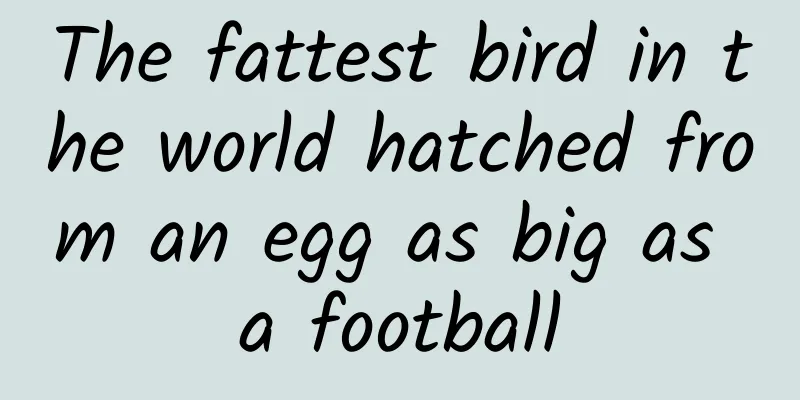The fattest bird in the world hatched from an egg as big as a football

|
Everyone who sees an elephant bird egg for the first time will ask the same question I did: "Is this real?" In 2018, funded by the China-Africa Joint Research Center of the Chinese Academy of Sciences, I, several colleagues and colleagues from the botanical garden flew to Madagascar to conduct a two-week plant diversity survey. After landing, several rows of decorations displayed in the restaurant attracted my attention - among them were two huge eggs like footballs. I began to look at them through the glass window. Elephant bird eggs | Vassil / Wikimedia Commons This is an egg restored by gluing together many broken eggshells with plaster. The eggshell fragments have been polished by time and apparently have no signs of mineralization. They have a luster like white marble and seem unreal, like man-made objects. However, the honeycomb-like pits on the eggshell are traces of pores, showing that they once provided breath for the life in the eggshell. This is the eggshell of an elephant bird, but life has long since ceased to exist. It existed in Madagascar 600 years ago. Giant monster on the island Walking on the beaches in southern Madagascar, you may still have the opportunity to pick up some fragments. Judging from some skeletal fossils and residual DNA that have survived to this day, research suggests that there were at least four species of elephant birds, belonging to the genera Aepyornis, Mullerornis and Vorombe. All of these elephant birds are much larger than the world's largest existing bird, the African ostrich (weighing about 130-150 kilograms). Most of the giant elephant birds (Aepyornis maximus) can be more than 3 meters tall and weigh 350-750 kilograms. Size comparison of birds and non-avian feathered dinosaurs. From left to right: Gigantoraptor, Utahraptor, Gigantosaurus, Ostrich, Deinonychus | Matt Martyniuk / Wikimedia Commons A 2018 study found that the Vorombe titan could have reached an astonishing record of 860 kilograms, which made it the heaviest bird known to humans, surpassing the giant moa (Dinornis robustus) that once lived in New Zealand and the Stromornis stirtoni that once lived in Australia. The size of an animal grows as a cube, while the cross-sectional area of the legs that determines its support capacity grows as a square. Therefore, the elephant bird's huge size also means that in all restoration drawings and models of the elephant bird, the elephant bird's legs are as thick as an elephant's, which looks intimidating and a bit funny. Elephant bird leg bone | Internet Archive Book Images / Flickr Islands are the cradle of many unique animals. In 1964, after studying 116 species of island creatures, zoologist J. Bristol Foster came to a surprising conclusion: animals living on islands often evolve changes in size. Specifically, large animals generally become smaller due to the lack of food sources, while small animals generally become larger due to the lack of natural enemies on the islands. This observation was further expanded and explained by the famous ecologists Robert MacArthur and Edward O. Wilson in 1978, forming the "island law" in animal geography. The dwarf elephants of Borneo, the giant stick insects of Lord Howe Island, and the giant hissing cockroaches of Madagascar are all footnotes to this theory. Elephant bird skeleton | LadyofHats / Wikimedia Commons Birds living on isolated islands have attracted more attention from evolutionary biologists. Many island birds have lost their ability to fly and have become larger on the islands. This process has occurred repeatedly in the evolutionary history of birds, including the kakapo, dodo, great auk, moa, and the less familiar Hawaiian giant goose. The flightless elephant birds hatched from huge eggshells are giant creatures that evolved in isolation on Madagascar, the fourth largest island in the world. The title of "the heaviest bird in the world" is so intriguing: what would people think when they first met them? The disappearance of the bird world Humans should be familiar with birds, and the answer may be even more disturbing. About 90 million years ago, the Indian subcontinent and Madagascar separated from the African continent. About 88 million years ago, the Indian subcontinent separated from Madagascar, and Madagascar began its eternal lonely drift in the Indian Ocean. The earliest traces of human activity found on the island appeared about 10,000 years ago. The Austronesian peoples who make up the majority of Madagascar residents today set out from Borneo in Southeast Asia and landed on Madagascar Island 1,500-2,300 years ago. The residents who arrived from the African continent arrived later. The indisputable fact is that when humans arrived in Madagascar, elephant birds had already been breeding here for a long time. Skeleton specimens of elephant birds and ostriches. From left to right: Mullerornis agilis, Aepyornis maximus, Aepyornis hildebrandti, Ostrich | Eric Buffetaut / Boletim do Centro Português de Geo-História e Pré-História (2018) So, when did the elephant bird arrive in Madagascar? It was once believed that the elephant bird might be closely related to the ostrich that exists on the African continent today, and that as Madagascar and the African continent drifted apart, the elephant bird and the ostrich parted ways and lived their own lives. However, the latest DNA systematics research suggests that the closest relative of the elephant bird among existing birds is the kiwi that lives across the ocean in New Zealand. This study has also triggered a rethinking of the causes of the geographical distribution of ratites, including ostriches, emus, rheas, cassowaries, kiwis, etc. It tells another story - it is speculated that the elephant bird and kiwi separated much later than the split of Gondwana. Perhaps the common ancestor of the elephant bird and other ratites, which still retained the ability to fly, migrated from South America to other large islands. In the peaceful and tranquil Madagascar and New Zealand, under the law of islands, they gave up the ability to fly and became hermits in the jungle. And this time will not be later than the Pliocene 27 million years ago. Even though there are no detailed written records of the encounter between humans and the elephant bird, the giant eggshell of the elephant bird has been preserved in legends and literature. In the story of "One Thousand and One Nights", the sailor Sinbad came to an island full of giant bird eggs, which were called "Roc". The giant bird appeared again in the story of Aladdin's magic lamp: the villain wizard asked Aladdin's wife for a "Roc" egg as a palace decoration, which angered the genie. In the 13th century "The Travels of Marco Polo", it was mentioned that the giant bird "rukh" entrenched on the big island, flying to cover the sky and the sun, and could grab an elephant with one claw... Egg size comparison. The largest is the elephant bird egg, followed by the moa egg and the ostrich egg. The smallest is the chicken egg. | Biodiversity Heritage Library / Flickr These stories are absurd in themselves, but they also show people's respect or fear for birds. In fact, the elephant bird is likely to feed on fruits like the cassowary in northern Australia. Madagascar's extremely rich and unique palm plants provide enough food for the elephant bird. Many palm plants unique to the Madagascar are now extremely endangered. One possible reason is that the extinction of the elephant bird has caused them to lose their seed dispersers. Humans and elephant birds coexisted on the island of Madagascar for quite a long time, which means that human hunting may not be the primary cause of the extinction of elephant birds. More and more studies have shown that habitat loss may be a more important factor - since humans landed on Madagascar, the island's forest vegetation has been decreasing significantly. The original forest has been reduced by 90%, and giant animals like elephant birds do not need a small breeding habitat, so they are victims of the destruction of forest resources. As a hunting commodity, some elephant bird eggs were sold overseas at high prices, and elephant bird eggshells were found in the remains of some islanders - elephant bird eggs were used as food and utensils, which made the survival of elephant birds even worse. Wells's science fiction novel: Æpyornis Island, where an elephant bird survives | Wikimedia Commons Such an amazing bird disappeared from the earth, and we don't even know when the extinction occurred. The existing intact elephant bird eggs, through isotope dating, are mostly more than 1,000 years old. For a long time before the French colonists invaded and colonized this beautiful island, no one had seen a living elephant bird. Today, Madagascar is one of the countries with the most serious soil erosion. Without the protection of forests, soil fertility is rapidly declining, and agriculture is difficult to develop. The giant birds that roamed the jungle are no longer a thing of the past. The islands are still home to many fascinating and unique wild animals and plants that are integrated into the entire island's ecological environment. Whether it is to lend a hand or work together, if we fail to think about the relationship between humans and other creatures, and all kinds of creatures, we will face the risk of repeating the mistakes of the elephant bird. |
<<: An 8-year-old boy was swept into the air by a fountain and died. How scary is this fountain?
Recommend
Weibo Fans Advertising Copywriting Method and Placement Suggestions!
To run Weibo Fans Channel advertising , whether y...
"I want you" - recruitment copywriting of the thousand-year-old ancient Zen temple, read more than 1,000,000 times, received more than 4,000 resumes
My Buddha is looking for wise men! Recently, Dong...
Jie Xiaojie · Popular methods and techniques course videos on short videos
Jie Xiaojie · Popular methods and techniques cour...
How much does a Arabian horse cost? How much does a French Arabian BMW cost?
How much does a Arabian horse cost? Normally, the...
Apple's flaw: iPhone 6's charging efficiency is not as good as mid-range phones
As functions become increasingly complete, the ba...
All of Toutiao’s operating strategies are here!
When it comes to traffic, you can’t escape the BA...
2020 Aion S launched: King of Evolution with more features but no price increase
On July 2, the annual upgraded model of GAC New E...
When attracting new users through APP, don’t forget to use “old customers bringing in new customers”!
If your users are willing to help you promote , t...
How to make an offline event promotion and operation plan?
This article is not only suitable for online even...
Alternative Pirates and Treasures TV version "Happy Pirates" first experience
Screen: operate: Sound Effects: Plot: Experience:...
Android 14 new security feature: IT administrators can now disable 2G networks
Google has introduced a new security feature in A...
If Weibo Blue V certification fails, do I need to pay 300 yuan again to apply for certification again?
No, you only need to provide the failed materials...
"Fake" is also very powerful, aerospace simulation products are very useful
Recently, the Indian Space Research Organization ...
A guide to marketing and screen-sweeping on Bilibili’s “Houlang”!
During the May 4th Youth Day not long ago, "...
How to conduct data analysis and account adjustments for Baidu's bidding promotion account?
As someone engaged in Baidu bidding promotion, yo...









